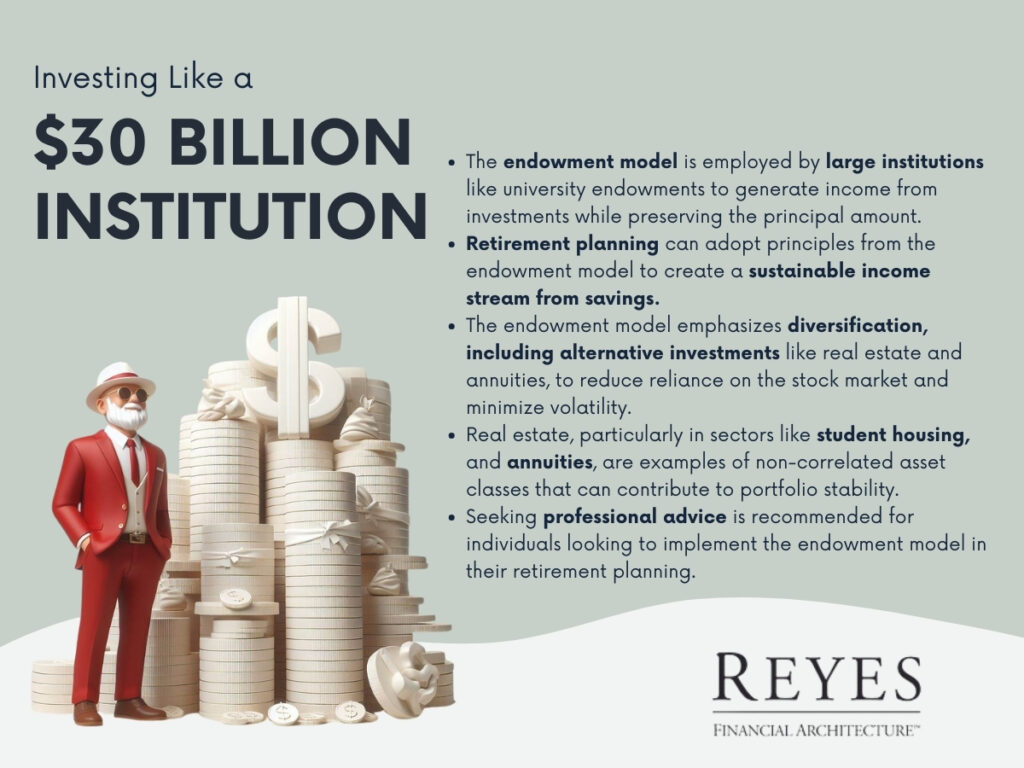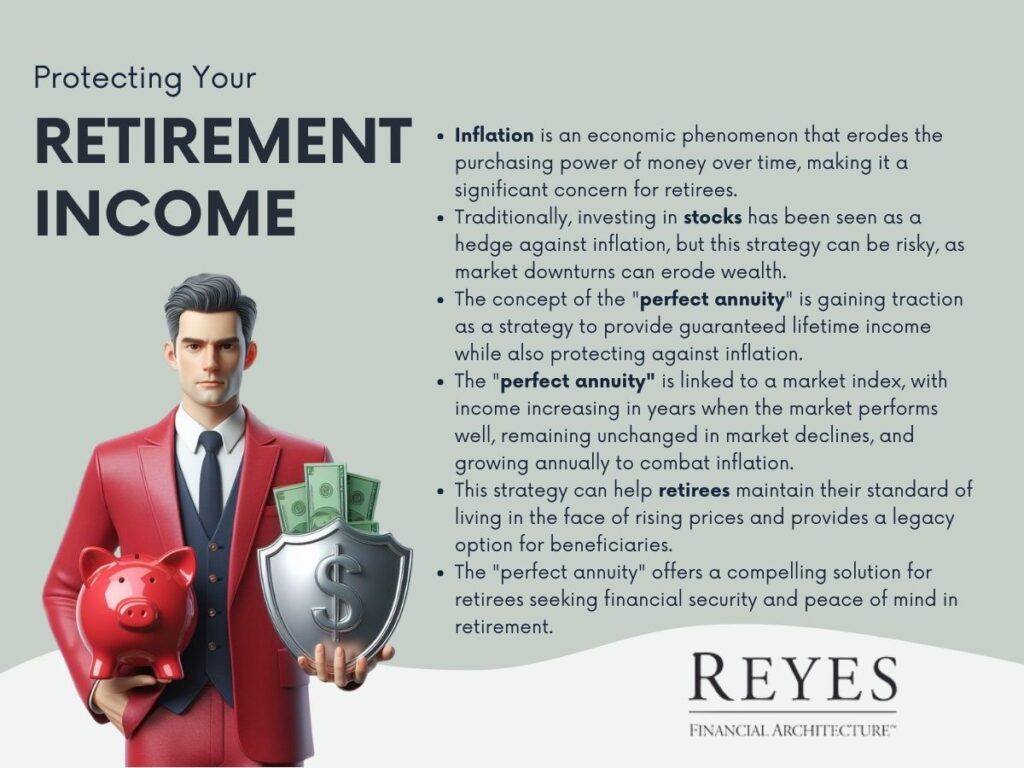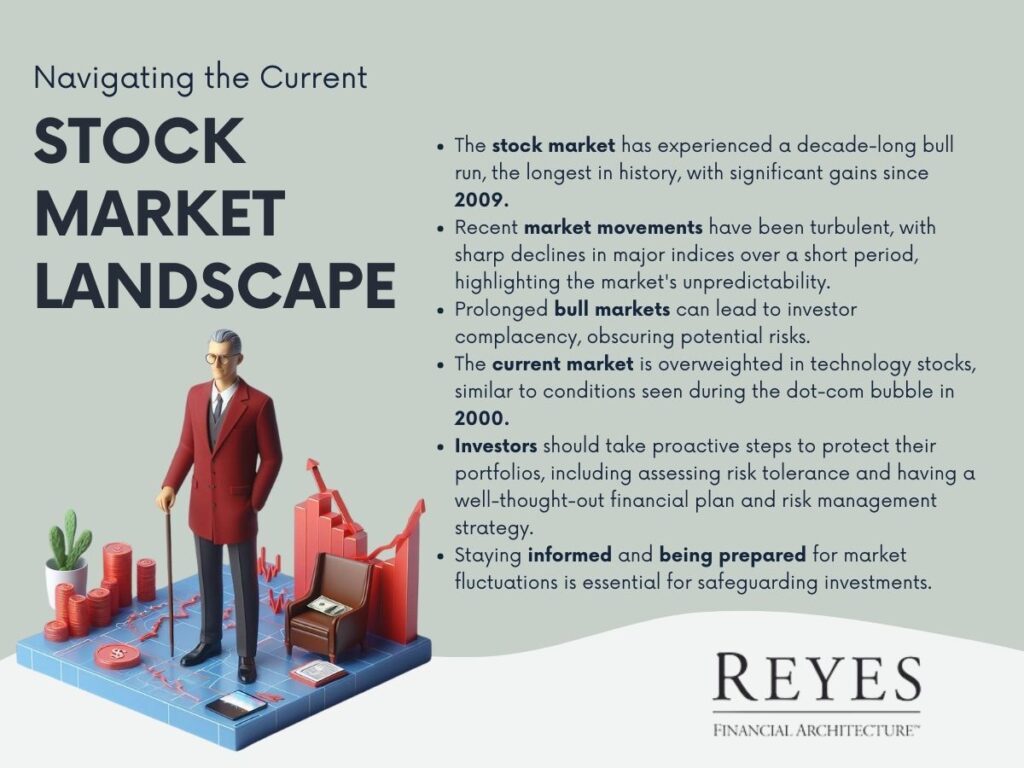Check out this video to learn more about the highly successful model David has infused into his planning process
In the realm of investment strategies, one of the more intriguing approaches is the endowment model, notably employed by large institutions like university endowments. This model, championed by figures like David Swensen of Yale University, offers unique insights for individual investors, especially those planning for retirement.

At its core, an endowment is a financial asset, like a fund, held by institutions such as universities. It’s made up of donations that are invested to generate income for the institution. The principal amount generally remains intact while the income supports various expenses.
The Yale endowment, under Swensen's management, became a hallmark of this approach. Yale’s strategy was not just successful but also revolutionary in how it diversified investments beyond the traditional stock and bond portfolio. This diversification aimed to achieve steady returns while minimizing risks.
Retirement planning can be akin to managing an endowment. In both cases, the goal is to create a sustainable income stream from a large pool of savings. The typical recommendation for endowment funds is to aim for a 5% annual distribution. This figure interestingly aligns with the retirement income strategies suggested by many financial planners.
However, a critical difference lies in the investment approach. Traditional retirement portfolios often focus heavily on stocks and bonds. In contrast, the endowment model advocates for a more diversified portfolio including alternative investments.
The endowment model’s success largely stems from its inclusion of alternative investments. These can range from private equity and hard assets like real estate to even more niche options like annuities. For instance, Yale’s portfolio in 2001 included a significant portion in hard assets, primarily real estate, alongside a smaller proportion in domestic and foreign equities.
This diversification strategy not only reduces reliance on the stock market but also potentially smoothens out returns, reducing volatility. The objective is to create a portfolio that can withstand market downturns better and provide more consistent returns over time.
Real estate, especially in sectors like student housing, is a prime example of an alternative investment that can offer stable returns. Properties near major universities, such as USC, Notre Dame, or Northwestern University, can provide a steady income stream, often with tax advantages.
Annuities are another diversifier in this model. While not directly linked to stock or bond markets, they can provide a steady income, adding another layer of stability to a retirement portfolio.
One of the key strengths of the endowment model is its use of non-correlated asset classes. Investments like real estate or annuities don’t necessarily move in tandem with the stock or bond markets. This non-correlation can significantly reduce the portfolio's overall risk.
For individual investors, adopting an endowment-like strategy means moving beyond the conventional wisdom of a stock-and-bond-dominated portfolio. It involves exploring and investing in a variety of asset classes. However, this approach requires careful planning and a thorough understanding of each investment type.
Given the complexity of this investment strategy, seeking professional advice is prudent. Financial advisors with experience in the endowment model can provide valuable insights and help tailor a portfolio that suits an individual’s retirement goals and risk tolerance.
The endowment model, inspired by the strategies of large institutions like Yale University, presents an innovative approach for individual investors, especially those in retirement planning.
Its focus on diversification across various asset classes aims to provide a balanced investment portfolio that can weather market volatility and generate sustainable income. While it may require stepping out of the traditional investment comfort zone, the potential for a more stable and robust retirement income is an enticing prospect for those willing to explore beyond stocks and bonds.
In 1980, Ronald Reagan famously compared inflation to a violent mugger, a frightening armed robber, and a deadly hitman. During the tumultuous 1970s and early 1980s, inflation rates soared, averaging around 13.5%. This period of rampant inflation had a profound impact on the cost of goods, effectively doubling them within a decade.
While we might have experienced a reprieve from high inflation in recent years, it's crucial to recognize that it can rear its head once more. This article delves into the critical relationship between inflation and investing, highlighting the often-overlooked concept of the "perfect annuity" as a tool to combat the eroding effects of inflation in retirement.

Inflation is an ever-present economic phenomenon that erodes the purchasing power of money over time. When you invest, especially in long-term assets like stocks, the goal is to outpace inflation and preserve the value of your wealth.
Traditionally, many have seen investing in stocks as a hedge against inflation, with the assumption that equities can generate returns that outpace the rising cost of living. However, this assumption doesn't always hold true, as evidenced by events like the 2008 financial crisis, which wiped out substantial portions of many portfolios.
Investors often face the challenge of ensuring that their income and wealth can withstand the corrosive effects of inflation, especially in retirement. While the concept of the "perfect annuity" may sound like an ideal solution, it remains a relatively obscure strategy. In this article, we aim to shed light on this innovative approach to safeguarding retirement income while simultaneously battling inflation.
The "perfect annuity" is a financial strategy designed to provide guaranteed lifetime income while also offering protection against inflation. This concept is gaining traction among financial advisors and retirees for its potential to address two significant retirement concerns: longevity risk and inflation risk.
Consider a scenario where an individual has a retirement portfolio of approximately $1 million. By strategically allocating a portion of this portfolio to a perfect annuity, they can secure an annual income for life. Over a 20-year period, assuming a conservative annual growth rate, their income will almost double, providing a reliable hedge against inflation.
One of the significant advantages of the perfect annuity is its resemblance to a pension. In most cases, when you choose a joint life expectancy option, both spouses can enjoy the same income benefits. Moreover, if there's a remaining balance upon the passing of the annuitant and their spouse, it can be passed on to beneficiaries, such as children, providing a legacy that many traditional annuities do not offer.
Inflation is an ever-present financial adversary, and safeguarding your retirement income against its erosive effects is paramount. The "perfect annuity" represents a powerful and relatively undiscovered tool in this battle.
By combining guaranteed lifetime income with the potential for income growth that keeps pace with inflation, this strategy offers a compelling solution for retirees seeking financial security and peace of mind.
It's a strategy worth considering as you plan for your retirement years and aim to ensure that your income not only lasts a lifetime but also remains resilient in the face of inflation's challenges.
In this article, we will explore the dynamics of the stock market and provide insights into its recent performance, potential risks, and important considerations for investors. While we often focus on various aspects of financial planning, it's crucial to address the current state of the market, especially given the unprecedented bull run we've witnessed over the past decade.

The stock market has experienced an exceptional 10-year bull run, marking its longest duration in history. Since 2009, the market has surged by more than 330%. To put it into perspective, if we were to compare this to a baseball game, we would be in extra innings.
However, the prolonged period of growth raises concerns and highlights the importance of being prepared for potential challenges ahead.
Recent market movements have been quite turbulent. For instance, in just three days in October, the Dow Jones Industrial Average experienced a sharp decline of 1,500 points, resulting in a 7% loss. The S&P 500, which had been up 9% year-to-date, saw its gains dwindle to nearly flat at just 1%. The Nasdaq also faced a 9% drop, with major tech companies like Netflix and Amazon witnessing substantial declines of 15% and 13%, respectively. These significant fluctuations occurred within a single week, emphasizing the market's unpredictability.
One of the primary concerns during a prolonged bull market is investor complacency. The more the market thrives, the more complacent investors tend to become. This complacency can be dangerous because it often obscures the potential risks that lie ahead.
As the famous adage by Warren Buffett goes, "When others are fearful, be greedy, and when others are greedy, be fearful." Currently, there seems to be a general eagerness to invest in the stock market, particularly in the tech sector.
The S&P 500 is currently overweighted by approximately 30% in technology stocks. This means that a significant portion of the S&P 500's value is attributed to technology companies. This level of overweighting in technology reminds us of the dot-com bubble in 2000, which led to an 80% decline in tech stocks.
Similarly, during the financial crisis, the S&P 500 had about 25% of its value tied to financial stocks, which subsequently lost 80%. The current overvaluation in technology stocks should not be underestimated.
Given the current market conditions and the looming risk of a downturn, it is crucial for investors to take proactive steps to protect their portfolios. While the idea of a bear market may seem alarming, it's essential to be prepared for potential losses ranging from 30% to even 50-60%. Being proactive and adequately prepared is the key to safeguarding your investments in such scenarios.
In conclusion, it is vital for investors to stay informed, assess their risk tolerance, and be ready to adapt their investment strategies in response to changing market conditions. Regardless of market circumstances, it is prudent to have a well-thought-out financial plan and risk management strategy in place. Your financial well-being is of paramount importance, and being prepared for market fluctuations is a responsible approach to safeguarding your investments.